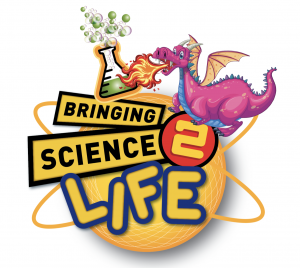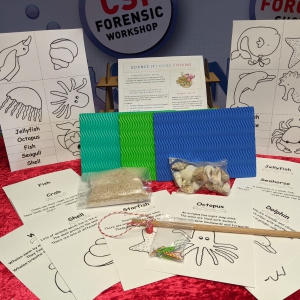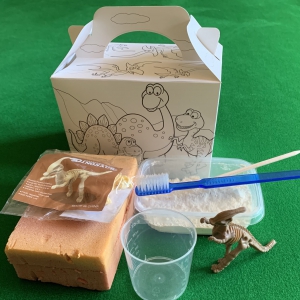Description
Highly detailed plastic dinosaur figures. There are several different models available including Tyrannosaurus rex, Stegosaurus, Brachiosaurus, Spinosaurus, Ceratosaurus and Triceratops.
This toy links with Scientific Sue’s The Scientific Dilemmas of Dippy the Dinosaur.
1: Tyrannosaurus Rex
Tyrannosaurus rex was one of the largest known theropod dinosaurs. It lived in what is now western North America in the latest Cretaceous Period (68-66 million years ago). Tyrannosaurus rex, often called ‘T. rex’ lived right up to the end of the Cretaceous Period, so was one of the last dinosaurs to have lived on earth.
- Scientific name: Tyrannosaurus rex meaning ‘tyrant lizard’ and ‘king’
- Characteristics: Tyrannosaurus, was large (at least 12 m long), stout and muscular (5-6 metric tons). It ran on its thick hind legs. Its huge jaws contained lots of sharp, 15 cm long teeth. Each tooth had a serrated blade on both the front and back edges that could easily have cut through any prey. Its front limbs were tiny and its hands had only two little fingers. We don’t know what these fingers were for, but they were far too small and weak to walk on, fight off other dinosaurs, or grasp prey.
- Size: This model is 18 cm long and 10 cm high. Like many living lizards, it is a dark green in its upper parts, and a light tan colour underneath.
2: Stegosaurus
One of the most popular and well-known dinosaurs, Stegosaurus was a very unique looking dinosaur, with its large armoured plates and distinctive tail spines. It lived during the Jurassic Period (around 150 million years ago) in the same time and place as Allosaurus. Broken tail spines and wound marks found in Allosaurus bones suggest that these two may have done battle with each other.
- Scientific Name: Stegosaurus (“covered” or “roofed” lizard) was named for the plates covering its back. Stegosaurus stenops is the type species.
- Characteristics: Stegosaurus is known from many complete skeletons, but the exact position of its tail spikes and dermal plates was long the subject of debate. It is now believed that the plates were arranged in an alternating pattern, with the tail spikes arranged in pairs. Some palaeontologists, suggest that the arrangement of plates may have differed between Stegosaurus species.
- Size: This Stegosaurus figure is 16 cm long and 7 cm in height.
3: Brachiosaurus
Brachiosaurus was a large sauropod dinosaur that lived during the Late Jurassic (155-150 million years ago) in what is now western North America.
- Scientific Name: Brachiosaurus
- Characteristics: Brachiosaurus was one of the largest dinosaurs, about 26 metres in length, and weighed about 35 metric tons. It had a very small head, long neck and tail, and walked on all fours. Unlike all other four-footed dinosaurs, the front legs of Brachiosaurus were longer, rather than shorter, than the hind legs. In combination with its long neck, this allowed Brachiosaurus to reach leaves at least 9 metres into the forest canopy, giving it a big advantage over all other herbivorous dinosaurs.
- Size: This model is 16 cm long and 10 cm high. Its huge size would have protected it from all but the largest predators.
4: Spinosaurus
The sail-backed Spinosaurus was one of the longest meat-eating dinosaurs of all time. This long-snouted theropod dinosaur was adapted for a semi-aquatic lifestyle. It hunted for fish in the river deltas of northern Africa during the late Cretaceous, 100 million years ago.
- Scientific Name: Spinosaurus aegyptiacus
- Characteristics: Spinosaurus was a giant carnivore with a spectacular tall sail running along its back, and a long snout filled with pointed conical teeth. It had short muscular legs with three-toed feet, and short arms with three-fingered hands and an enlarged claw on its thumb. It could reach massive sizes up to 49 feet long.
- Size: This model is 15 cm long and 9 cm high.
5: Ceratosaurus
The horned Ceratosaurus is one of the most distinctive meat-eating dinosaurs. This medium-sized predator lived in North America and Europe during the Jurassic, around 150 million years ago.
- Scientific Name: Ceratosaurus nasicornis
- Characteristics: Ceratosaurus was a slender carnivore with a distinctive large skull with a blade-like horn on its snout and a small horn over each eye. It walked on two long legs and had three-toed feet and sharp curved claws. It had very short but powerful arms with four-fingered hands, although only three fingers had claws. It had rows of small bony plates embedded in the skin of its neck and back, and had a long tail to help it stay balanced. The largest specimens suggest adults reached up to 22 feet long.
- Size: This figure is 18 cm long and 12 cm high.
6: Triceratops
The three-horned Triceratops is the most famous – and most gigantic – of all the horned dinosaurs. This iconic animal browsed for plants in North America during the Late Cretaceous, 65 million years ago.
- Scientific Name: Triceratops horridus
- Characteristics: Triceratops is best known for its horns: a short one on its nose, and a long horn over each eye. Triceratops has a curved beak, and a solid bony frill on the back of its head. It walked on four short robust legs. Its front legs have five toes, of which three have blunt claws, and the hind feet have four large toes with hoof-like claws. At 8 m long it was one of the largest horned dinosaurs.
- Size: This model is 15 cm long and 6 cm high.










